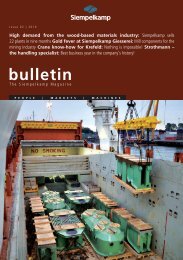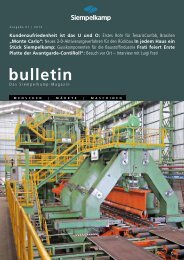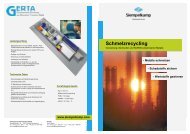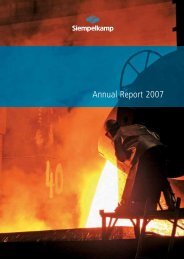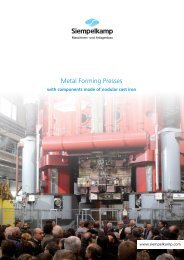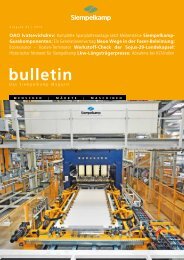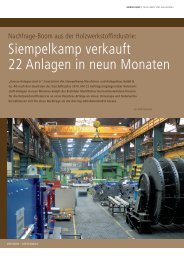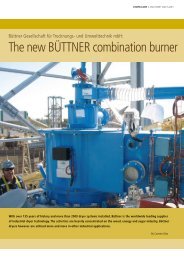Bulletin 1/2011 - Siempelkamp
Bulletin 1/2011 - Siempelkamp
Bulletin 1/2011 - Siempelkamp
You also want an ePaper? Increase the reach of your titles
YUMPU automatically turns print PDFs into web optimized ePapers that Google loves.
Special lifting devices for nuclear technology –<br />
completely by <strong>Siempelkamp</strong>:<br />
<strong>Siempelkamp</strong> utilizes<br />
synergy potentials<br />
the cross-divisional collaboration offers many advantages: For<br />
Snt customers the concept pays off in high-quality production.<br />
the cooperation avoids friction losses thanks to an effective interface<br />
management and provides direct con trol. “Furthermore, it<br />
ensures to protect the technical production skills and the Snt<br />
know-how regarding lifting devices stays in-house,” summarizes<br />
Michael Szukala, Managing Director of Snt.<br />
Nuclear technology + machine and plant engineering =<br />
bridging two sectors<br />
the existing infrastructure provided the best conditions to approach<br />
the lifting device business together under the <strong>Siempelkamp</strong><br />
umbrella. In 2006/2007 the machine and engineering business<br />
unit invested largely in its production facility to produce ever<br />
higher quality products. this includes the mechanical machining<br />
of rollers for ContiRoll® presses and large components from<br />
<strong>Siempelkamp</strong> Foundry, but also components for the nuclear technology<br />
unit to meet the highly technical requirements for this<br />
sector.<br />
For customers in China and Germany, both <strong>Siempelkamp</strong> business<br />
units are currently providing proof of their bundled competence.<br />
For the current new building projects taishan I and II,<br />
<strong>Siempelkamp</strong> manufactures and supplies reactor pressure vessel<br />
(RPV) lifting devices for the RPV closure head. the German nuclear<br />
power plants Grafenrheinfeld and Unterweser will each receive<br />
a multi-purpose lifting device which will be used for the handling<br />
of pressure vessel internals.<br />
Lifting devices for the reactor pressure vessel closure heads<br />
at Taishan I + II<br />
In 2009 <strong>Siempelkamp</strong> nukleartechnik received the order for the<br />
supply of two lifting devices for the new nuclear power plant<br />
units I + II in taishan, China. these lifting devices will carry out the<br />
lifting and lowering of the reactor pressure vessel closure head<br />
SieMpelkaMp | nUCLEAR tECHnOLOGy<br />
and represent a protection system for the control rod drives<br />
against outside impacts. the lifting devices incorporate the complete<br />
cabling for the instrumentation, the control system and the<br />
control of the control rod drives. For the removing of the head,<br />
the bolted connections in the flange and then plug connections<br />
have to be loosened first. Afterwards, the polar crane can transport<br />
the head to the storage location. the head weighs about<br />
180 t (198 US tons).<br />
Another task of the lifting devices involves the support of the 89<br />
control rod drives sticking out from the pressure vessel head. In<br />
the case of an outside impact, a bending or snapping off of the<br />
control rod drives has to be prevented because only fully functional<br />
control rods allow the shutting down of the reactor. this support<br />
becomes possible with four restraint systems connecting the<br />
lifting device with the building and a complex honeycomb structure<br />
in the central ring of the lifting device supporting the 89<br />
control rod drives. the upper lifting rig, which is part of the lifting<br />
device for the closure head, also transports and handles the tensioning<br />
device and insulation materials.<br />
One multi-purpose lifting device each for the nuclear<br />
power plants Grafenrheinfeld and Unterweser<br />
the multi-purpose lifting devices for the nuclear power plants<br />
Grafenrheinfeld and Unterweser, which were ordered from<br />
<strong>Siempelkamp</strong> nukleartechnik in 2010, are lifting devices for the<br />
handling of pressure vessel internals. this includes the upper and<br />
lower core grid with and without the rods of the control rod drive.<br />
the weight lifting capacity of the lifting device amounts to 50,000<br />
kg (55 US tons) on the suspension bolts raising the upper core<br />
grid. 152,000 kg (167 US tons) is the estimated lifting capacity for<br />
the gripping tongs for raising the upper and lower core grid.<br />
the multi-purpose lifting device also makes it possible to place<br />
the shielding or sealing head on the reactor pressure vessel.





